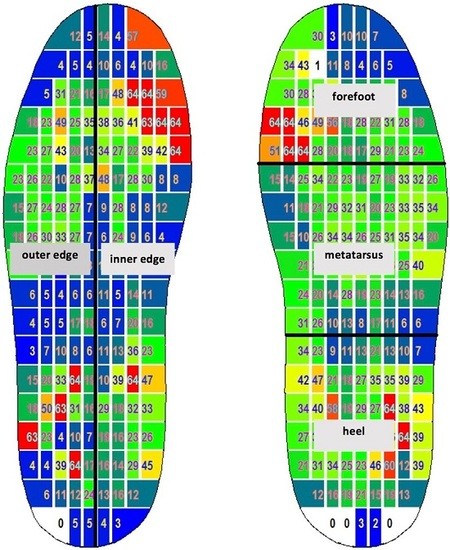Changes in Plantar Pressure While Running with a Jogging Stroller
Abstract
:1. Introduction
2. Materials and Methods
2.1. Participants
2.2. Bilateral Insole Pressure Measurement
2.3. Procedures
3. Results
4. Discussion
Author Contributions
Conflicts of Interest
Abbreviations
| WS | with jogging stroller |
| NS | no jogging stroller |
| COM | center of mass |
| GRF | ground reaction force |
| BOS | base of support |
References
- Brown, G.A.; Scott, M.L.; Harris, J., III; Colaluca, M.K.; Rebok, M.P. Economy of jogging stroller use during running. Med. Sci. Sports Exerc. 2004, 36, S248. [Google Scholar]
- Smith, J.D.; Kinser, K.B.; Dugan, E.; Reed, M. Physiological and biomechanical responses while running with and without a stroller. J. Sports Med. Phys. Fit. 2005, 45, 270–276. [Google Scholar]
- Brown, G.A.; Rebok, M.P.; Scott, M.L.; Harris, J., III; Colaluca, M.K.; Shaw, B.S.; Shaw, I. Physiological and biomechanical responses of running with and without a stroller. Afr. J. Phys. Health Educ. Recreat. Dance 2008, 14, 240–249. [Google Scholar]
- Gregory, D.A.; Pfeiffer, K.A.; Vickers, K.E.; Aubrey, A.J.; Flynn, J.I.; Connolly, C.P.; Coe, D.P. Physiologic responses to running with a jogging stroller. Int. J. Sports Med. 2012, 33, 711–715. [Google Scholar] [CrossRef] [PubMed]
- O’Sullivan, R.; Kiernan, D.; Malone, A. Run kinematics with and without a jogging stroller. Gait Posture 2016, 43, 220–224. [Google Scholar] [CrossRef] [PubMed]
- Alkjær, T.; Larse, P.K.; Pedersen, G.; Nielsen, L.H.; Simonsen, E.B. Biomechanical analysis of rollator walking. Biomed. Eng. Online 2006, 5, 1–7. [Google Scholar] [CrossRef] [PubMed]
- Suica, Z.; Romkes, J.; Tal, A.; Maguire, C. Walking with a four wheeled walker (rollator) significantly reduced EMG lower-limb muscle activity in healthy subjects. J. Bodyw. Mov. Ther. 2016, 20, 65–73. [Google Scholar] [CrossRef] [PubMed]
- Ishikura, T. Biomechanical analysis of weight bearing force and muscle activation levels in lower extremities during gait with a walker. Acta Med. Okayama 2001, 55, 73–82. [Google Scholar] [PubMed]
- Borg, G. Borg’s Perceived Exertion and Pain Scales; Human Kinetics: Champaign, IL, USA, 1998. [Google Scholar]
- Mickel, C.; Schmidtbleicher, D. Vergleich des freien Gehens mit dem Gehen auf dem Laufband–eine EMG-Studie. Sportverletz. Sportschaden 2009, 23, 133–137. [Google Scholar] [CrossRef]
- Nelson, R.C.; Dillman, C.J.; Lagasse, P.; Bickett, P. Biomechanics of overground versus treadmill running. Med. Sci. Sports 1972, 4, 233–240. [Google Scholar] [CrossRef] [PubMed]
- Wank, V.; Frick, U.; Schmidtbleicher, D. Kinematics and electromyography of lower limb muscles in overground and treadmill running. Int. J. Sports Med. 1998, 19, 455–461. [Google Scholar] [CrossRef] [PubMed]
- Schubert, A.G.; Kempf, J.; Heiderscheit, B.C. Influence of stride frequency and length on running mechanics. A systematic review. Sports Health 2014, 6, 210–217. [Google Scholar] [CrossRef] [PubMed]
- Thompson, M.A.; Gutmann, A.; Seegmiller, J.; Mcgowan, C.P. The effect of stride length on the dynamics of barefoot and shod running. J. Biomech. 2014, 47, 2745–2750. [Google Scholar] [CrossRef] [PubMed]
- Heiderscheit, B.C.; Chumanov, E.S.; Michalski, M.P.; Wille, C.M.; Ryan, M.B. Effects of step rate manipulation on joint mechanics during running. Med. Sci. Sports Exerc. 2011, 43, 296–302. [Google Scholar] [CrossRef] [PubMed]
- Allet, L.; Ijzerman, H.; Meijer, K.; Willems, P.; Savelberg, H. The influence of stride-length on plantar foot-pressures and joint moments. Gait Posture 2011, 34, 300–306. [Google Scholar] [CrossRef] [PubMed]
- Shinde, C.V.; Wang, W.; Abboud, R.J.; Cochrane, L. Analysis of foot pressure variation with change in stride length. J. Dent. Med. Sci. 2014, 13, 46–51. [Google Scholar]
- Bateni, H.; Maki, B.E. Assistive devices for balance and mobility: Benefits, demands and adverse consequences. Arch. Phys. Med. Rehabil. 2005, 86, 134–145. [Google Scholar] [CrossRef] [PubMed]
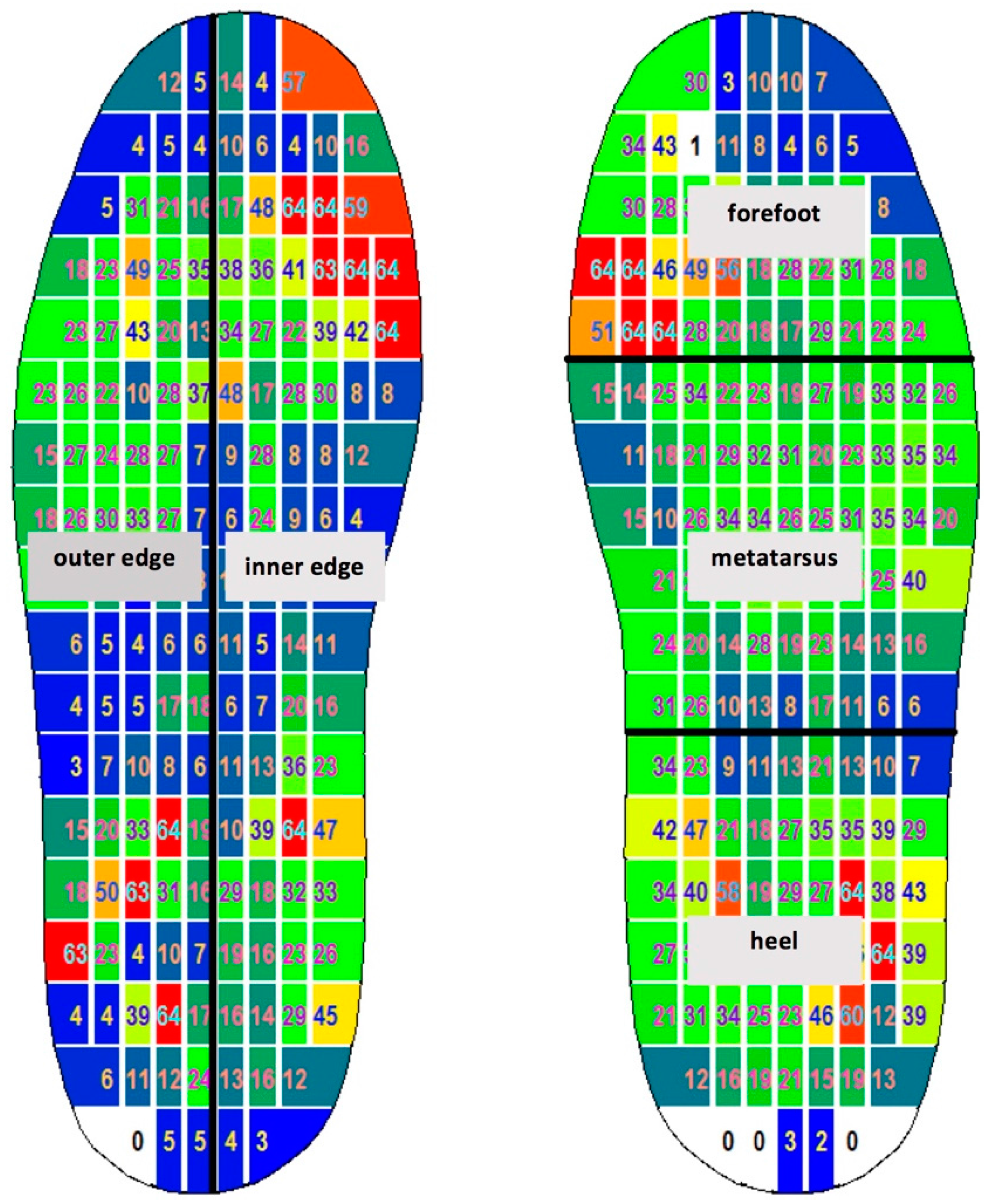
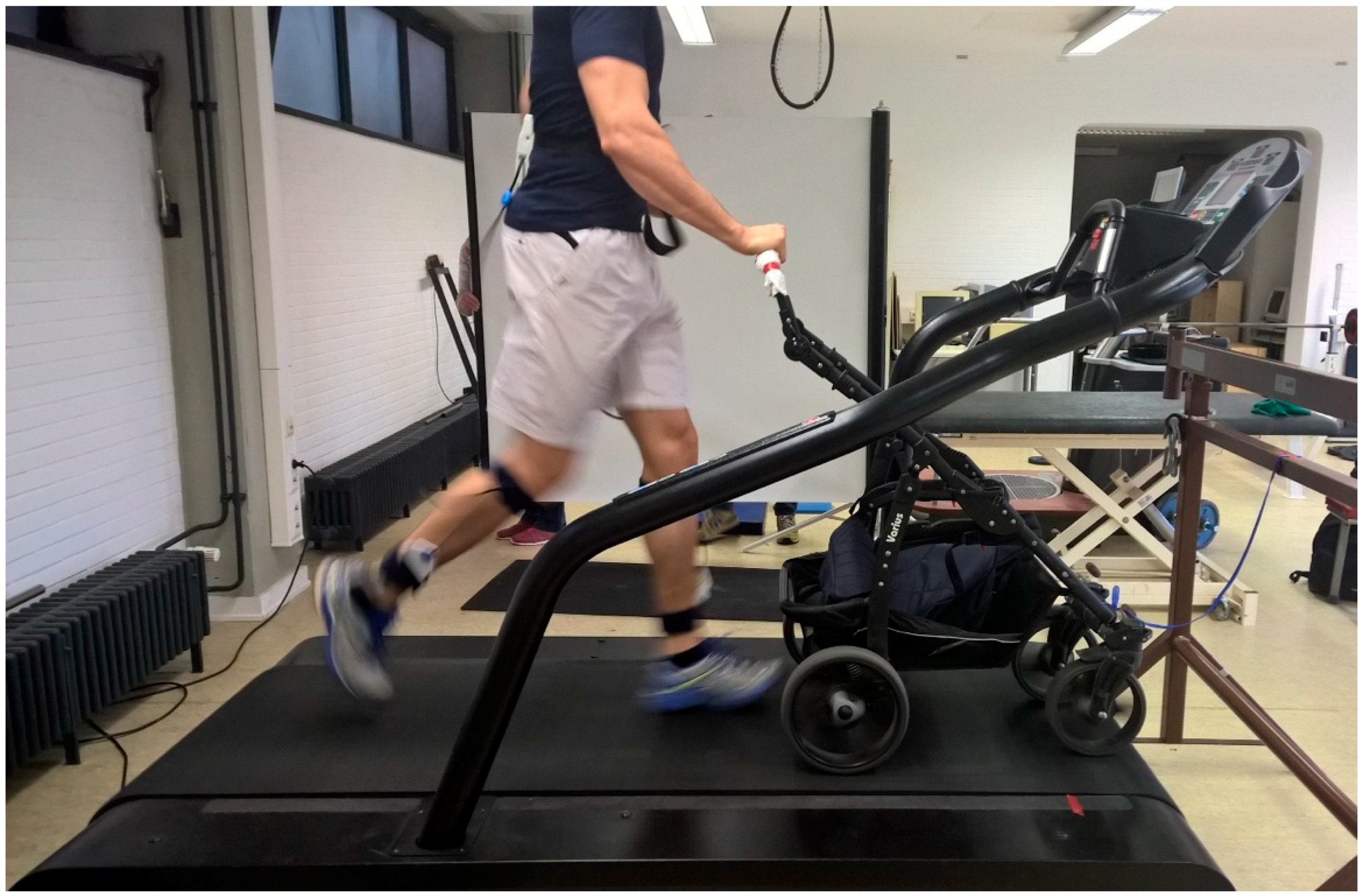
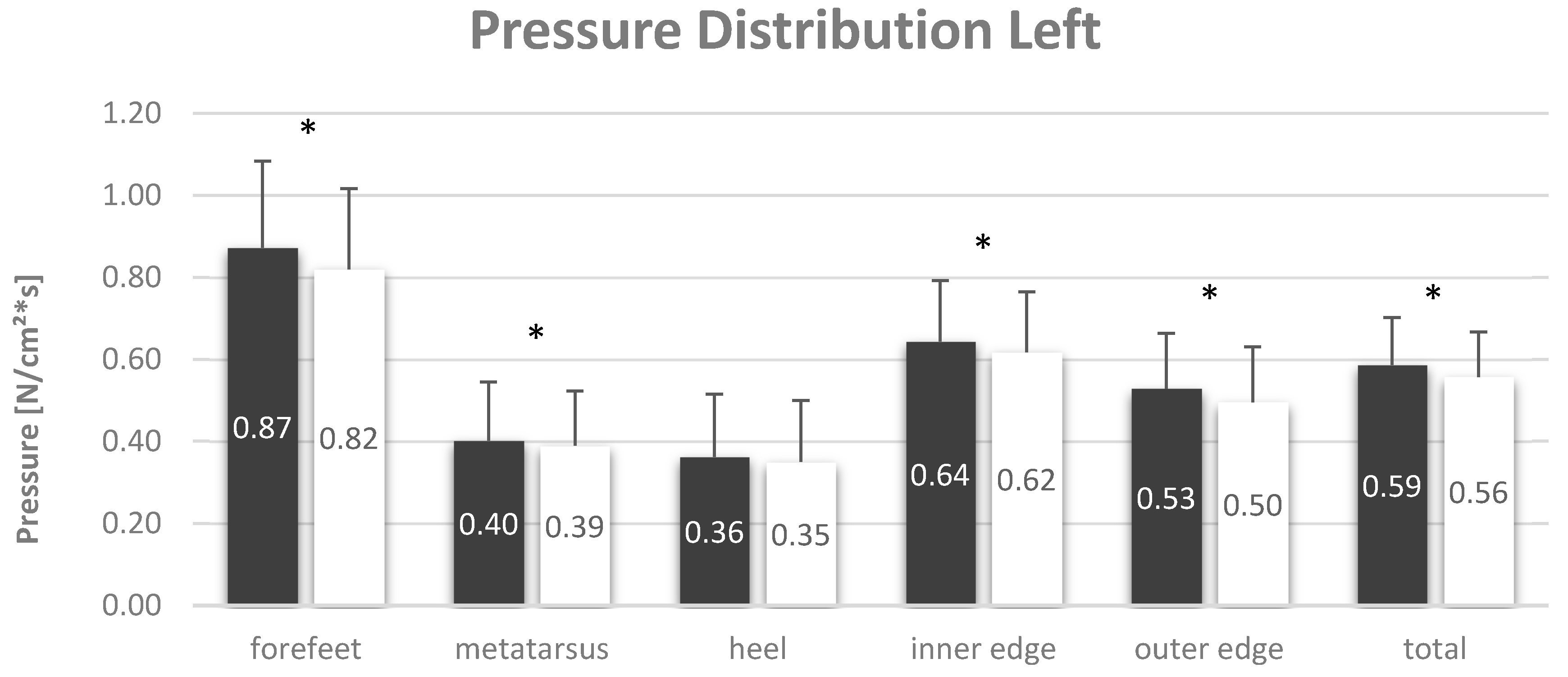
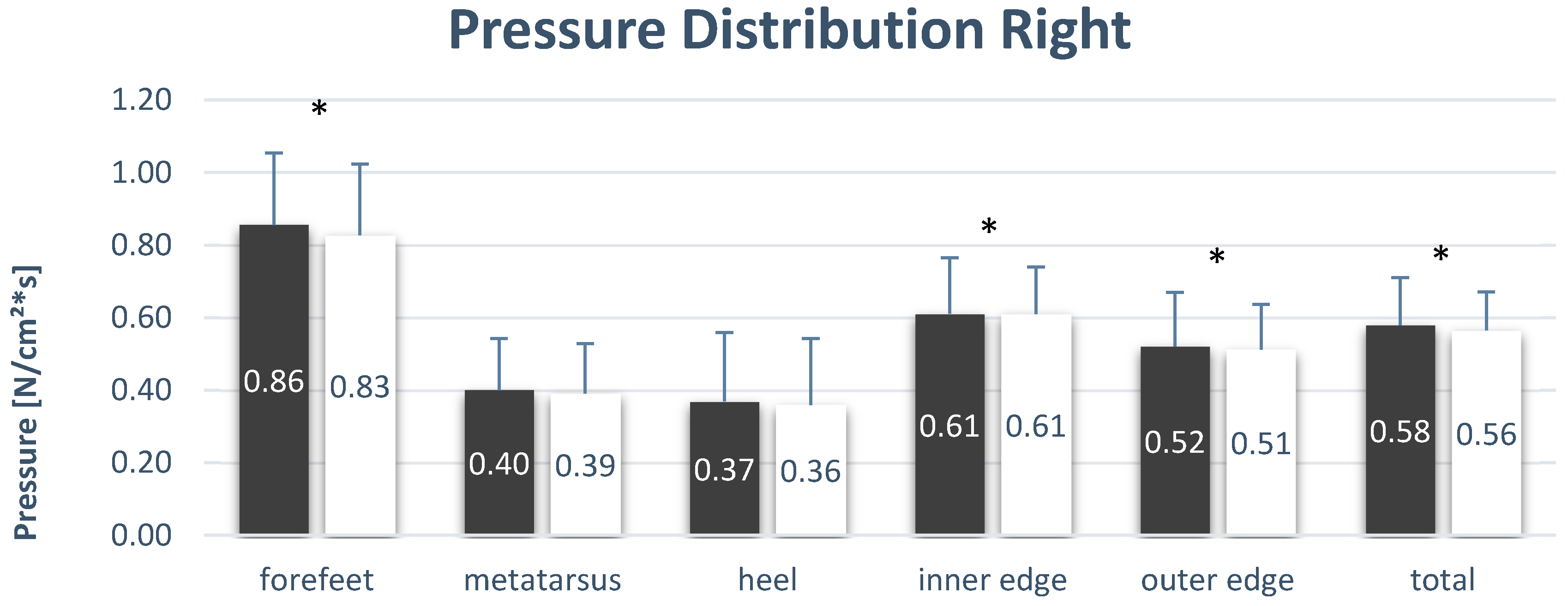
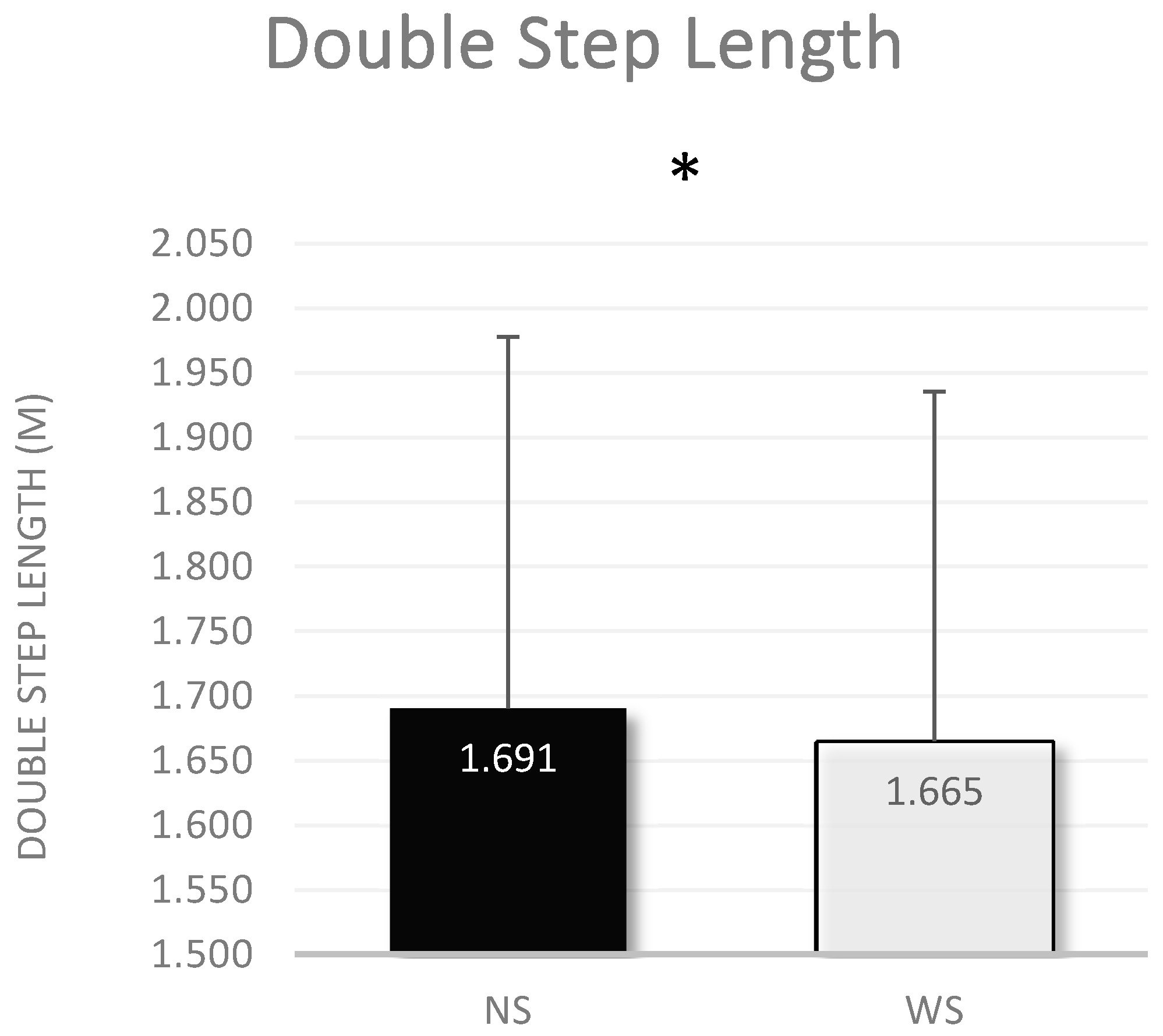

© 2016 by the authors; licensee MDPI, Basel, Switzerland. This article is an open access article distributed under the terms and conditions of the Creative Commons Attribution (CC-BY) license (http://creativecommons.org/licenses/by/4.0/).
Share and Cite
Mickel, C.; Baltrusch, A.; Holzgreve, F.; Maltry, L.; Hartmann, H.; Keiner, M.; Wirth, K. Changes in Plantar Pressure While Running with a Jogging Stroller. J. Funct. Morphol. Kinesiol. 2016, 1, 314-321. https://doi.org/10.3390/jfmk1030314
Mickel C, Baltrusch A, Holzgreve F, Maltry L, Hartmann H, Keiner M, Wirth K. Changes in Plantar Pressure While Running with a Jogging Stroller. Journal of Functional Morphology and Kinesiology. 2016; 1(3):314-321. https://doi.org/10.3390/jfmk1030314
Chicago/Turabian StyleMickel, Christoph, Antonia Baltrusch, Fabian Holzgreve, Laura Maltry, Hagen Hartmann, Michael Keiner, and Klaus Wirth. 2016. "Changes in Plantar Pressure While Running with a Jogging Stroller" Journal of Functional Morphology and Kinesiology 1, no. 3: 314-321. https://doi.org/10.3390/jfmk1030314





